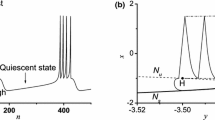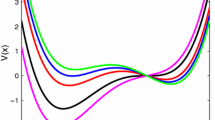Abstract
As the value of a control parameter decreases, monostable bursting changes to monostable spiking via the coexistence of spiking and bursting in a Leech neuron model, and the attraction domain of the bursting decreases, while that of the coexisting spiking increases for coexisting behaviors. As the coupling strength increases, the two coupled Leech neurons with the coexisting spiking and bursting manifest transitions from non-synchronization to complete synchronization (CS) through a complex process, which is dependent of the values of the control parameter, cases of configurations (one neuron spiking and the other bursting, both bursting, and both spiking), and the initial values of the two neurons. The transition processes involve various spiking and bursting or chaos synchronization states for the first two cases given here, but contain only spiking patterns for the last case. Corresponding with the attraction domain, the probability of initial values that can lead to bursting patterns of CS decreases, but the probability of initial values that can induce spiking of CS increases for the former two cases, as the control parameter is decreased. This phenomenon can also be interpreted by the structure and volume of the attraction domain with which all initial values can only induce CS of spiking for case 3. The results may improve understanding of the synchronization dynamics of the coupled neurons with coexisting behaviors.



















Similar content being viewed by others
References
Arenas, A., Díaz-Guilera, A., Kurths, J., Moreno, Y., Zhou, C.S.: Synchronization in complex networks. Phys. Rep. 469(3), 93–153 (2008)
Glass, L.: Synchronization and rhythmic processes in physiology. Nature 410(6825), 277–284 (2001)
Gu, H.G., Pan, B.B., Xu, J.: Experimental observation of spike, burst and chaos synchronization of calcium concentration oscillation. EPL 106(5), 50003 (2014)
Singer, W., Gray, C.M.: Visual feature integration and the temporal correlation hypothesis. Annu. Rev. Neurosci. 18(1), 555–586 (1995)
Llinás, R., Ribary, U.: Coherent 40-Hz oscillation characterizes dream state in humans. Proc. Natl. Acad. Sci. USA 90(5), 2078–2081 (1993)
Hartline, D.K.: Pattern generation in the lobster (Panulirus) stomatogastric ganglion. II. Pyloric network simulation. Biol. Cybern. 33(4), 223–236 (1979)
Kim, K.H., Yoon, J., Kim, J.H., Junq, K.Y.: Changes in gamma-band power and phase synchronization with the difficulty of a visual oddball task. Brain Res. 1236, 105–112 (2008)
Choi, J.W., Jung, K.Y., Kim, C.H., Kim, K.H.: Changes in gamma-and theta-band phase synchronization patterns due to the difficulty of auditory oddball task. Neurosci. Lett. 468(2), 156–160 (2010)
Bartsch, R., Kantelhardt, J.W., Penzel, T., Havlin, S.: Experimental evidence for phase synchronization transitions in the human cardiorespiratory system. Phys. Rev. Lett. 98, 54102 (2007)
Batista, C.A., Viana, R.L., Ferrari, F.A., Lopes, S.R., Batista, A.M., Coninck, J.C.: Control of bursting synchronization in networks of Hodgkin–Huxley-type neurons with chemical synapses. Phys. Rev. E 87(4), 042713 (2013)
Pecora, L.M., Carroll, T.L.: Synchronization in chaotic systems. Phys. Rev. Lett. 64(8), 821–824 (1990)
Gómez-Gardeñes, J., Gómez, S., Arenas, A., Moreno, Y.: Explosive synchronization transitions in scale-free networks. Phys. Rev. Lett. 106(12), 128701 (2011)
Droz, M., Lipowski, A.: Dynamical properties of the synchronization transition. Phys. Rev. E 67(5), 056204 (2003)
Liang, X., Tang, M., Dhamala, M., Liu, Z.: Phase synchronization of inhibitory bursting neurons induced by distributed time delays in chemical coupling. Phys. Rev. E 80(6), 066202 (2009)
Wang, Q.Y., Chen, G.R., Perc, M.: Synchronous bursts on scale-free neuronal networks with attractive and repulsive coupling. PLoS One 6(1), e15851 (2011)
Dhamala, M., Jirsa, V.K., Ding, M.Z.: Transitions to synchrony in coupled bursting neurons. Phys. Rev. Lett. 92(2), 028101 (2004)
Sun, X.J., Lei, J.Z., Perc, M., Kurths, J., Chen, G.R.: Burst synchronization transitions in a neuronal network of subnetworks. Chaos 21(1), 016110 (2011)
Sun, X.J., Han, F., Wiercigroch, M., Shi, X.: Effects of time periodic intercoupling strength on burst synchronization of a clustered neuronal network. Int. J. Nonlinear Mech. 70, 119–125 (2015)
Buzki, G., Draguhn, A.: Neuronal oscillations in cortical networks. Science 304(5679), 1926–1929 (2004)
Gray, C.M., König, P., Engel, A.K., Singer, W.: Oscillatory responses in cat visual cortex exhibit inter-columnar synchronization which reflects global stimulus properties. Nature 338(6213), 334–337 (1989)
Ozbudak, E.M., Thattai, M., Lim, H.N., Shraiman, B.I., van Oudenaarden, A.: Multistability in the lactose utilization network of Escherichia coli. Nature 427(6976), 737–740 (2004)
Guttman, R., Lewis, S., Rinzel, J.: Control of repetitive firing in squid axon membrane as a model for a neuroneoscillator. J. Physiol. 305(1), 377–395 (1980)
Izhikevich, E.M.: Neurol exitability, spiking and bursting. Int. J. Bifurcat. Chaos 10(6), 1171–1266 (2000)
Tateno, T., Pakdaman, K.: Random dynamics of the Morris–Lecar neural model. Chaos 14(3), 511–530 (2004)
Lechner, H.A., Baxter, D.A., Clark, J.W., Byrne, J.H.: Bistability and its regulation by serotonin in the endogenously bursting neuron R15 in Aplysia. J. Neurophysiol. 75(2), 957–962 (1996)
Fröhlich, F., Bazhenov, M.: Coexistence of tonic firing and bursting in cortical neurons. Phys. Rev. E 74(3), 031922 (2006)
Cymbalyuk, G., Shilnikov, A.: Coexistence of tonic spiking oscillations in a leech neuron model. J. Comput. Neurosci. 18(3), 255–263 (2005)
Xu, Y.L., Yang, M.H., Liu, Z.Q., Liu, H.J., Gu, H.G., Ren, W.: Three cases of the bifurcation from period 1 to period 2 bursting in theoretical and experimental neural models. Dyn. Contin. Discrete Impuls. Syst. Ser. B 14(S5), 35–40 (2007)
Pisarchik, A.N., Jaimes-Reátegui, R., García-López, J.H.: Synchronization of coupled bistable chaotic systems: experimental study. Philos. Trans. R. Soc. A 366(1864), 459–473 (2008)
Pisarchik, A.N., Jaimes-Reátegui, R., García-López, J.H.: Synchronization of multistable systems. Int. J. Bifurcat. Chaos 18(6), 1801–1819 (2008)
Pisarchik, A.N., Jaimes-Reátegui, R., Villalobos-Salazar, J.R., García-López, J.H., Boccaletti, S.: Synchronization of chaotic systems with coexisting attractors. Phys. Rev. Lett. 96(24), 244102 (2006)
Sausedo-Solorio, J.M., Pisarchik, A.N.: Dynamics of unidirectionally coupled bistable Hénon maps. Phys. Lett. A 375(42), 3677–3681 (2011)
Ruiz-Oliveras, F.R., Pisarchik, A.N.: Synchronization of semiconductor laser with coexisting attractors. Phys. Rev. E 79(1), 016202 (2009)
Wang, Q.Y., Duan, Z.S., Feng, Z.S., Chen, G.R., Lu, Q.S.: Synchronization transition in gap-junction-coupled leech neurons. Phys. A 387(16), 4404–4410 (2008)
Gu, H.G., Li, Y.Y., Jia, B., Chen, G.R.: Parameter-dependent synchronization transition of coupled neurons with co-existing spiking and bursting. Phys. A 392(15), 3281–3292 (2013)
Jia, B.: Synchronization transition of coupled neurons with coexisting behaviors near a sub-critical Hopf bifurcation. Chin. Phys. B 23, 050510 (2014)
Gu, H.G., Chen, S.G., Li, Y.Y.: Complex transitions between spike, burst or chaos synchronization states in coupled neurons with coexisting bursting patterns. Chin. Phys. B 24(5), 050505 (2015)
Shilnikov, A., Calabrese, R.L., Cymbalyuk, G.: Mechanism of bistability: tonic spiking and bursting in a neuron model. Phys. Rev. E 71(5), 056214 (2005)
Cymbalyuk, G.S., Calabrese, R.L.: A model of slow plateau-like oscillations based upon the fast Na\({^+}\) current in a window mode. Neurocomputing 38, 159–166 (2001)
Shilnikov, A., Cymbalyuk, G.: Transition between tonic spiking and bursting in a neuron model via the blue-sky catastrophe. Phys. Rev. Lett. 94(4), 048101 (2005)
Gu, H.G.: Experimental observation of transitions from chaotic bursting to chaotic spiking in a neural pacemaker. Chaos 23(2), 023126 (2013)
Gu, H.G., Xiao, W.W.: Difference between intermittent chaotic bursting and spiking of neural firing patterns. Int. J. Bifurcat. Chaos 24(6), 1450082 (2014)
Gu, H.G., Pan, B.B., Chen, G.R., Duan, L.X.: Biological experimental demonstration of bifurcations from bursting to spiking predicted by theoretical models. Nonlinear Dyn. 78(1), 391–407 (2014)
Gu, H.G., Chen, S.G.: Potassium-induced bifurcations and chaos in neural firing patterns observed from a biological experimental pacemaker. Sci. China Technol. Sci. 57(5), 864–871 (2014)
Gu, H.G.: Biological experimental observation of an unnoticed chaos as simulated by the Hindmarsh–Rose model. PLoS One 8(12), e81759 (2013)
Cross-correlation coefficient. https://en.wikipedia.org/wiki/Correlation_and_dependence
Abe, H., Tsumoto, S.: Knowledge-Based Intelligent Information and Engineering Systems. Springer, Germany (2010)
Wang, H.J., Huang, H.B., Qi, G.X.: Coexistence of anticipated and layered chaotic synchronization in time-delay systems. Phys. Rev. E 72(3), 037203 (2005)
Pikovsky, A., Zaks, M., Rosenblum, M., Osipov, G., Kurths, J.: Phase synchronization of chaotic oscillations in terms of periodic orbits. Chaos 7(4), 680–687 (1997)
Chen, J.Y., Wong, K.W., Shuai, J.W.: Phase synchronization in coupled chaotic oscillators with time delay. Phys. Rev. E 66(5), 056203 (2002)
Taherion, S., Lai, Y.C.: Observability of lag synchronization of coupled chaotic oscillators. Phys. Rev. E 59(6), R6247 (1999)
Corron, N.J., Blakely, J.N., Pethel, S.D.: Lag and anticipating synchronization without time-delay coupling. Chaos 15(2), 023110 (2005)
Wu, X., Ma, J.: The formation mechanism of defects, spiral wave in the network of neurons. PLoS One 8(1), e55403 (2013)
Ma, J., Huang, L., Wang, C.N., Pu, Z.S.: Robustness, death of spiral wave in the network of neurons under partial ion channel block. Commun. Theor. Phys. 59(2), 233 (2013)
Qin, H.X., Ma, J., Jin, W.Y., Wang, C.N.: Dynamics of electric activities in neuron and neurons of network induced by autapses. Sci. China Technol. Sci. 57(5), 936–946 (2014)
Song, Z.G., Xu, J.: Codimension-two bursting analysis in the delayed neural system with external stimulations. Nonlinear Dyn. 67, 309–328 (2012)
Song, Z.G., Xu, J.: Bifurcation and chaos analysis for a delayed two-neural network with a variation slope ratio in the activation function. Int. J. Bifurcat. Chaos 22(05), 1250105 (2012)
Song, Z.G., Xu, J.: Stability switches and Bogdanov-Takens bifurcation in an inertial two-neuron coupling system with multiple delays. Sci. China Tech. Sci. 57(5), 893–904 (2014)
Author information
Authors and Affiliations
Corresponding author
Additional information
This work was supported by the National Natural Science Foundation of China under Grant Nos. 11372224 and 11402039 and the Fundamental Research Funds for Central Universities designated to Tongji University under Grant No. 1330219127.
Rights and permissions
About this article
Cite this article
Gu, H., Pan, B. & Li, Y. The dependence of synchronization transition processes of coupled neurons with coexisting spiking and bursting on the control parameter, initial value, and attraction domain. Nonlinear Dyn 82, 1191–1210 (2015). https://doi.org/10.1007/s11071-015-2226-7
Received:
Accepted:
Published:
Issue Date:
DOI: https://doi.org/10.1007/s11071-015-2226-7




